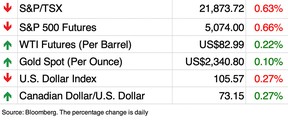Article content

Conditions are shaping up for the Bank of Canada to start cutting interest rates, but will our currency throw a wrench in the works?


Steep drop in currency could hike inflation by 1%, says BofA

Conditions are shaping up for the Bank of Canada to start cutting interest rates, but will our currency throw a wrench in the works?
Article content
Expectations that Canada’s central bank will move before the United States Federal Reserve has put pressure on the loonie, which has dropped 1.7 per cent against a strong U.S. dollar.
The Canadian dollar fell again yesterday after weaker retail sales data added to the case for rate cuts.
Advertisement 2
Article content
As the gap between the two central banks’ policy paths widens, the loonie’s outlook dims.
While the Bank of Canada is expected to cut rates in June or July, predictions for the Fed’s first cut have been pushed back to December, with some questioning whether it will cut at all this year.
The Bank of Canada is expected to trim 100 to 125 basis points off its 5 per cent rate this year; the Fed only 25 bps.
How big this gap gets is a key question for the Canadian dollar.
BofA Global Research has cut its outlook for the currency on signs the divergence will be wider than previously expected.
It now forecasts the Canadian dollar will fall to 72.99 US cents in the second quarter of this year, and reach 75.75 US cents by the end of 2025, down from its earlier forecast of 76.9 US cents.
A weaker Canadian dollar raises the risks of inflation as goods become more expensive to import. BofA estimates that each big drop in the Canadian dollar could add 15 bps to the consumer price index. If the gap between the two central banks grows wide enough to push the loonie down to 69 US cents it could hike inflation by a full percentage point, they said.
Article content
Advertisement 3
Article content
“For now, we believe the BoC would likely tolerate some short-term loonie weakness as it looks to embark on the rate cutting cycle,” said BofA strategist Howard Du and economist Carlos Capistran.
“But should the BoC rate cuts lead to sharp CAD selloff or a prolonged period of CAD downtrend, the FX market would likely start to become concerned with renewed inflation risks for Canada and the consequences a strong USD imposes on rest of the world including Canada.”
This could raise concerns about how deeply the Bank of Canada can cut or whether policy makers will be forced to pause to allow the Fed to catch up.
Governor Tiff Macklem said at the bank’s last decision on April 10 that policy makers were watching the currency.
“If the Canadian dollar does move, that’s something that we’ll take into account in terms of our outlook,” he told reporters.
The Bank of Canada has intervened before, said the BofA researchers. After the 1997 Asia financial crisis the loonie was hammered by a strong American dollar and falling oil prices. In August to September of 1998 Canada’s central bank raised its policy rate by 100 bps and conducted direct intervention in the FX market.
Advertisement 4
Article content
“The current macro backdrop is still far from a crisis level and risk of BoC intervention is low,” said Du and Capistran.
“But should the CAD see excessive weakness after the BoC rate cutting cycle starts, this is a risk that market should not ignore, in our view.”
Not all economists agree. Nathan Janzen, assistant chief economist at the Royal Bank of Canada, argues that currencies have not “moved the needle” on inflation in the past.
More than half of Canadian consumer spending is on services and goods are imported from more sources than the United States. Canada’s weaker economy also makes it harder for businesses to pass on price increases.
Bank of Montreal senior economist Sal Guatieri, however, does think the Canadian dollar could become an issue for the central bank.
“So far, the weak loonie is adding welcomed support to the economy without threatening prices stability. But that could change if it takes a further swan dive,” he said.
Sign up here to get Posthaste delivered straight to your inbox.

Slumping retail sales added more ammunition to the case for a Bank of Canada interest rate cut in June, economists said yesterday. Retail sales fell 0.1 per cent in February, missing expectations of a slight increase. Combined with January’s 0.3 per cent plunge and an estimate of flat sales in March, the first quarter is set to be the slowest in almost a year.
Advertisement 5
Article content
“Overall, this report highlights the weak consumer backdrop in Canada … and we continue to expect a June rate cut from the Bank of Canada,” Katherine Judge, an economist with the Canadian Imperial Bank of Commerce, said in a note Wednesday.
Yields on two-year Canadian government bonds fell about three basis points after the data came out, and the Canadian dollar dropped to 72.9 US cents, suggesting markets also boosted their bets on a June cut.
“All in, this data flow should keep a June BoC rate cut on the table, inflation willing …,” said Bank of Montreal senior economist Robert Kavcic.
We’ll get the answer to that in the next consumer price index report on May 21, just a few weeks before the Bank of Canada decides on rates June 5.
Advertisement 6
Article content

The federal budget did not contain a general tax rate increase for the wealthy or anyone else, but the government did increase the capital gains inclusion rate and amended the draft alternative minimum tax rules in response to concerns from the charitable sector. Tax expert Jamie Golombek details what you need to know.
Recommended from Editorial
Are you worried about having enough for retirement? Do you need to adjust your portfolio? Are you wondering how to make ends meet? Drop us a line at aholloway@postmedia.com with your contact info and the general gist of your problem and we’ll try to find some experts to help you out while writing a Family Finance story about it (we’ll keep your name out of it, of course). If you have a simpler question, the crack team at FP Answers led by Julie Cazzin or one of our columnists can give it a shot.
Advertisement 7
Article content
Want to learn more about mortgages? Mortgage strategist Robert McLister’s Financial Post column can help navigate the complex sector, from the latest trends to financing opportunities you won’t want to miss. Read them here
Today’s Posthaste was written by Pamela Heaven with additional reporting from Financial Post staff, The Canadian Press and Bloomberg.
Have a story idea, pitch, embargoed report, or a suggestion for this newsletter? Email us at posthaste@postmedia.com.
Bookmark our website and support our journalism: Don’t miss the business news you need to know — add financialpost.com to your bookmarks and sign up for our newsletters here.
Article content